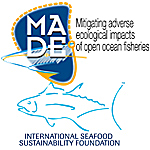Knowing that several pelagic species associate with floating structures, fishers have been using man-made fish aggregating devices (FADs) to facilitate their catch of these species. However, our understanding of this associative behaviour and its adaptive value is poor and the scientific community is ill-equipped to provide fishery managers with science-based recommendations on the impacts of FADs on ecosystems. The durations of the FAD-associated and unassociated behavioural phases of 72 acoustically tagged yellowfin tuna (Thunnus albacares) in an array of FADs around Oahu, Hawaii, were studied during four years. Data were analyzed using survival curves with the objective of determining the behavioural dynamics of fish joining and leaving the FADs. Survival curves were best fitted with exponential models, meaning that underlying behavioural processes were time independent. FAD-associated phases were characterized by four behavioural modes with average durations of 13.1 min, 2.9 days, 13.8 days and 23.2 days. Two modes were observed for unassociated phases: short (2.8 days) and long (infinite). There was no predictive relationship among these phases. The duration of the associated period is likely to depend on local conditions existing around a FAD at a given time, whereas the durations of unassociated periods may depend on broader-scale oceanic conditions. In each case, the conditions may correspond to biotic factors and/or social interactions. Individuals exhibited behavioural plasticity, switching between short and long modes for the associated phase. This suggests that large pelagic fish display a range of responses to changing environmental circumstances, highlighting the complexity involved in this associative behaviour.
- Presentation

 PDF version
PDF version
